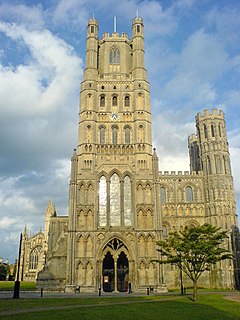Ely, Cambridgeshire
Ely (![]() pronunciation (help·info); IPA /'iːli/, rhyming with "freely") is a cathedral city in the East Cambridgeshire district of Cambridgeshire in the east of England and 23 km (14.3 mi) north north-east of Cambridge.
pronunciation (help·info); IPA /'iːli/, rhyming with "freely") is a cathedral city in the East Cambridgeshire district of Cambridgeshire in the east of England and 23 km (14.3 mi) north north-east of Cambridge.
| City of Ely | |
|---|---|
 West façade of Ely Cathedral from Palace Green, the former village green | |
| Area | 23 sq mi (60 km2) [1] |
| Population | 15,102 (2001 Census) |
| • Density | 657/sq mi (254/km2) |
| OS grid reference | TL5379 |
| Civil parish |
|
| District | |
| Shire county | |
| Region | |
| Country | England |
| Sovereign state | United Kingdom |
| Post town | ELY |
| Postcode district | CB6, CB7 |
| Dialling code | 01353 |
| Police | Cambridgeshire |
| Fire | Cambridgeshire |
| Ambulance | East of England |
| UK Parliament | |
| Website | East Cambridgeshire District Council |
Ely has been called a city for a long time because it has a cathedral. However, the Royal Charter making it a city was only issued in 1974. Ely's population was 15,102 in 2001. This means Ely is the third smallest city in England. Only after Wells in Somerset and the City of London which are smaller.
The University of Cambridge rowing team has a boathouse on the bank of the river and train there for the annual Boat Race against the University of Oxford.
The 1944 Boat Race was raced on the River Great Ouse near Ely, the only time it has not been held on the River Thames. The race was won by Oxford despite Cambridge being ahead early in the contest.
Landscape change
Ely is built on an clay which is one of the highest points in the Fens. This is very different to the West of Cambridgeshire which is made up of limestone. The river Great Ouse runs through the city, and is one of the longest rivers in the UK with many others flowing into it. The drainage area of the rivers that form the Great Ouse is around 6000 square miles (16,000 square kilometres). This is five times larger than the Fens itself The landscape was a large marsh until the 18th century, when much of the Fens was drained, making Ely no longer an island. Because of this, the ground around the city is very fertile and most of the region is used for farming. The marshes also had many different animals in them such as the Eel, which the city is named after.
Climate change
Cambridgeshire is one of the driest counties in Britain. It is protected from coastal wind from the east. It gets an average of 24 inches (600mm) of rain per year. Because of this, Cambridgeshire is warm in summer and cold and frosty in winter.
| Weather data for the area, an average from 1970 - 2000 | |||||||||||||
|---|---|---|---|---|---|---|---|---|---|---|---|---|---|
| Month | Jan | Feb | Mar | Apr | May | Jun | Jul | Aug | Sep | Oct | Nov | Dec | Year |
| Average high °C (°F) | 7.0
(44.6) |
7.4
(45.3) |
10.2
(50.4) |
12.6
(54.7) |
16.5
(61.7) |
19.4
(66.9) |
22.2
(72) |
22.3
(72.1) |
18.9
(66) |
14.6
(58.3) |
9.9
(49.8) |
7.8
(46) |
14.1
(57.4) |
| Average low °C (°F) | 1.3
(34.3) |
1.1
(34) |
2.9
(37.2) |
4.0
(39.2) |
6.7
(44.1) |
9.8
(49.6) |
12.0
(53.6) |
11.9
(53.4) |
10.1
(50.2) |
7.1
(44.8) |
3.7
(38.7) |
2.3
(36.1) |
6.1
(43) |
| Average rainfall mm (inches) | 45.0
(1.772) |
32.7
(1.287) |
41.5
(1.634) |
43.1
(1.697) |
44.5
(1.752) |
53.8
(2.118) |
38.2
(1.504) |
48.8
(1.921) |
51.0
(2.008) |
53.8
(2.118) |
51.1
(2.012) |
50.0
(1.969) |
553.5
(21.791) |
| Source: Met Office Archived 2019-01-07 at the Wayback Machine | |||||||||||||
References change
- ↑ "Historic Census Population Figures". Cambridgeshire County Council. 2010. Archived from the original (XLS) on 2011-06-09. Retrieved 20 August 2010.